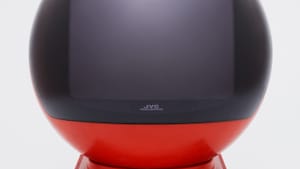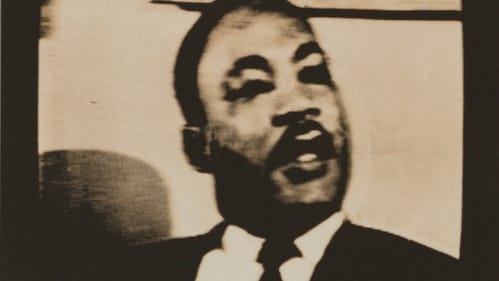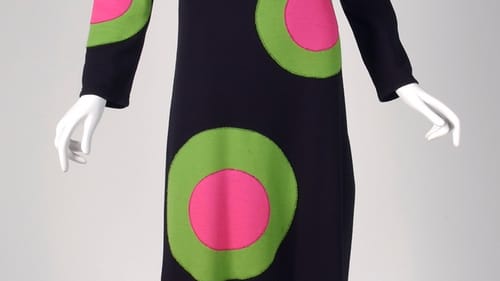Stay in the Loop
BSR publishes on a weekly schedule, with an email newsletter every Wednesday and Thursday morning. There’s no paywall, and subscribing is always free.
Déjà vu all over again
Philadelphia Museum of Art presents 'Design in Revolution: A 1960s Odyssey'

I think we’ve been here before. Design in Revolution: A 1960s Odyssey demonstrates that we may be reliving the 1960s — with better technology and less optimism. The anarchic style of that boundary-breaking, mind-blowing, risk-taking, love- and violence-filled decade unfolds in art and artifacts at Philadelphia Museum of Art.
Take a seat
The ‘60s ethos can be read in what was worn, listened to, hung on walls, and sat upon. There are a lot of chairs in the Collab Gallery of PMA’s Perelman Building, not to mention a sofa — Olivier Mourgue’s “Djinn Double Arm Sofa” (1962-63) — featured in the 1968 film 2001: A Space Odyssey.
The chairs are scattered like tea leaves, waiting to be read. The “Joe Chair” (Studio DDL, 1970) fills the entrance, beckoning viewers to take a trip back in time. It’s a loveseat-sized leather baseball glove, created by designers with a deep affection for Yankee great Joe DiMaggio, who became a heroic touchstone for the tumultuous era. DiMaggio was similarly referenced in the film The Graduate (1967) in Simon and Garfunkel’s “Mrs. Robinson,” an anthem for the confusion and cynicism of the age.
Another symbol memorably mentioned in The Graduate, plastics, invaded American life in the 1960s and is repeatedly represented here as the primary component of shapely, stackable seating.
Then there is the beanbag, identified as the most popular and copied design of the decade. The Italian-designed original, the “Sacco” (1968) by Gatti, Paolini, and Teodoro, is here. Still in wide circulation, the chair has been separating the young and limber from the old and creaky for half a century.
The sound of silence
Loops of archival film depict watershed moments from the ‘60s: Woodstock, antiwar and civil rights protests, and the moon landing. Though they unspool silently, the sounds are indelibly inscribed in the mind. It’s impossible not to hear the voice of Joan Baez, chants of college protesters, and Neil Armstrong immortalizing his first step on the lunar surface.

The 1960s divided people along political, racial, regional, and generational lines. The assassinations of public figures, including President John F. Kennedy, Medgar Evers, Martin Luther King Jr., and Robert F. Kennedy, were all made inescapable by television, which delivered them live into living rooms. This point is underscored by Martin Luther King Funeral Series (1968), grainy photographs Dean Brown made from the broadcast of the civil rights leader’s funeral.
Television was a portal to some of the decade’s worst moments and to some of its best. Space exploration offered wondrous relief to a world in turmoil. Throughout the ‘60s, Americans gathered with religious devotion to watch liftoffs and splashdowns of Gemini and Apollo missions. Many artifacts prove how thoroughly space invaded life on earth.
Commemorative lithographs From the Moon, Man Must Moon, Man in the Moon, and Moon Tripping are among several items by designer Peter Max marking the 1969 Apollo 11 moon landing. Executed in Max’s trademark style, the fluid, psychedelic figures seem ready to ooze like mercury beyond their frames.
Nearby are UFO Hanging Lamp (Yki Nummi, 1960) and Videosphere Television (Victor Company, Japan, 1970), a perfect replica of an astronaut’s helmet and reflective visor. These items signify how thinking about space transformed over 10 years, from a place inhabited by little green men to one in which men (and eventually women) might live.
Music: a visual experience
The music of the 1960s was the product of deeply held beliefs and whimsical inspiration, ego, love, hurt, hate, hope, and sometimes recreational drugs. Before the personalized playlist and earbuds, music was a communal experience: Teens bought albums, listened at parties, and waited by the radio for that song.

Concert posters and album art, music’s visual component, cover several walls and show how broad the ‘60s soundtrack was. Numerous album covers are on view, on loan from PMA staff members, including the Rolling Stones’ Let it Bleed (1969), David Bowie’s Space Oddity (1969), and Herb Alpert and the Tijuana Brass’s Whipped Cream and Other Delights (1965).
The fabric of our life
Design in Revolution includes an array of items that might have been found in average homes. Inger Persson’s intensely colored tea set, “Pop Service” (1972), and Roy Lichtenstein’s “Dinner Service” (1966) brought vibrant hues and pop art to the tabletop.
An array of textiles and clothing are on view, including Rudi Gernreich’s “Woman’s Long Dress” (late ‘60s–early ‘70s), a black knit shot through with bull’s eyes in lime green and hot pink. With or without pharmaceutical enhancement, cotton psychedelic prints here can induce dizziness. Gaze into Barbara Brown’s “Expansion” (1966) and John Stephen’s “Man’s Op Art Shirt” (1965) and hold on.
Throughout the 1960s, events conspired to shake civilization. Confronted with a world they didn’t recognize and couldn’t control, people adapted. By 1970, they believed, thought, and behaved quite differently than they had 10 years earlier.
The results were reflected in things they did control — what they wore, how they furnished homes, the art they appreciated, and music they enjoyed. The exhibit makes the case that revolutions in design begin in the heart and mind.
What, When, Where
Design in Revolution: A 1960s Odyssey. Through September 9, 2018, at the Philadelphia Museum of Art's Perelman Building, 2525 Pennsylvania Avenue, Philadelphia. (215) 763-8100 or philamuseum.org.
Sign up for our newsletter
All of the week's new articles, all in one place. Sign up for the free weekly BSR newsletters, and don't miss a conversation.